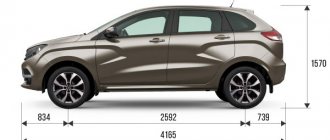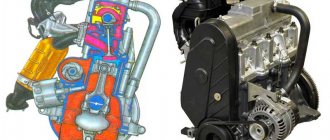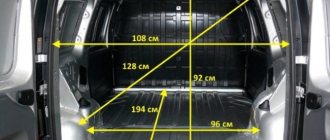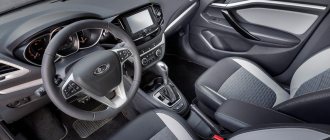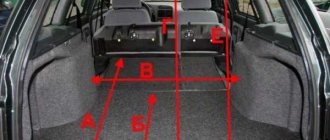Creation of VAZ-2101
Everyone knows that the VAZ 2101, or in common parlance “Kopeyka”, copied the external features and technical features from the Italian Fiat-124 model of 1966.
Of course, all materials for production were used only Soviet ones. The first stage of the plant was put into operation on March 24, 1971 and was designed to produce 220,000 cars per year. The following year, AvtoVAZ doubled its production capacity.
The VAZ-2101 was created as a low-power car (four-cylinder engine capacity was 1.2 liters; power - 62 hp at 600 rpm; maximum speed - 140 km/h) and with a relatively low price, so that everyone could afford to buy a legendary car.
Compared to the Italian prototype, the VAZ-2101 acquired rear drum brakes (instead of disc brakes), which were more durable and resistant to dirt. According to the characteristics of our roads, the ground clearance was also increased, the body and suspension were strengthened. In all subsequent years, the VAZ model was refined and subjected to modifications. But even in this (pristine) form, the VAZ-2101 was produced until 1982 and became a truly “people's” car.
Body geometry of the VAZ 2114 and its meaning
Violations of the body geometry have certain consequences, which are reflected in the general condition of the car in the following ways:
- Deterioration in controllability and vibration when accelerating (manifests itself at 80 km/h and above).
- Increased tire wear.
- Noise from suspension elements.
- Increased fuel consumption, etc.
The VAZ 2114 has a hatchback body type, for which, however, as for other types (station wagon, sedan, etc.), violation of the geometry affects various parameters.
The symmetry of the wheels is broken, as can be judged by:
- reducing vehicle stability on the highway;
- uneven tire wear.
The diagonals of the body are broken, which is noticeable in the frames of the front/rear windows and in the doorways of the car.
Specific folds may form on the bottom or frame.
For cars that are used for a long time on roads of poor quality, it is recommended to periodically check the geometry of the body (at least 1-2 times a year).
Characteristics of VAZ 2101
Domestic car designers paid special attention to modifications to the VAZ 2101 for more comfortable operating conditions in our country. As you know, the road surface in Russia is significantly different from Italy, so the body and suspension were significantly strengthened, which improved the technical characteristics of the VAZ 2101. The rear disc brakes from Fiat were replaced with drum ones. This was explained by their durability and resistance to dust and dirt, for which Soviet roadways were famous.
Almost everything has changed, and most importantly, the engine design. Automotive designers increased the distance between the cylinders (this made it possible to bore the diameter of the cylinders) and moved the camshaft to the cylinder head. Changes also affected the clutch, gearbox, and rear suspension. As a result, the weight of the car increased by 90 kg. In total, there were more than 800 changes and differences in the design of the VAZ 2101.
From 1970 to 1986, the plant produced almost three million VAZ 2101 cars. When 19 years passed after the car was released, the AvtoVAZ Museum was replenished with a new attraction - the VAZ-2101.
Salon VAZ-21074
The design of all modifications of the VAZ-2107 family (including the VAZ-21074 injector) provides for the arrangement of components and assemblies according to the so-called classical scheme, when the rear wheels are driven and the engine is shifted forward as much as possible, thereby ensuring optimal weight distribution along the axles and, as a result, improving vehicle stability. Thanks to this arrangement of the power unit, the interior turned out to be quite spacious and was located inside the wheelbase, i.e., in the zone of best ride smoothness, which could not but affect the comfort of the car.
The interior of the VAZ-21074 turned out to be quite spacious and comfortable
The interior trim is made of high-quality non-glare materials. The floor is covered with mats made of non-woven material on a polypropylene base. The body pillars and doors are upholstered in semi-rigid plastic, covered on the front side with caprovelor; velutin is used for seat upholstery. The ceiling is finished with polyvinyl chloride film with a duplicated foam pad, glued to a base formed from plastic. Through the use of various mastics, layered bitumen gaskets and felt inserts:
- heat and sound insulation of the interior is achieved;
- vibration is eliminated;
- Metal components are protected from corrosion.
Technical parameters of VAZ 2101
| Engine | 1.2l, 8-cl. | 1.2l, 8-cl. | 1.3l, 8-cl. |
| Length, mm | 4073 | 4043 | 4043 |
| Width, mm | 1611 | 1611 | 1611 |
| Height, mm | 1440 | 1440 | 1440 |
| Wheelbase, mm | 2424 | 2424 | 2424 |
| Front track, mm | 1349 | 1349 | 1349 |
| Rear track, mm | 1305 | 1305 | 1305 |
| Ground clearance, mm | 170 | 170 | 170 |
| Minimum trunk volume, l | 325 | 325 | 325 |
| Body type/number of doors | Sedan/4 | ||
| Engine location | Front, longitudinal | ||
| Engine volume, cm3 | 1198 | 1198 | 1300 |
| Cylinder type | Row | ||
| Number of cylinders | 4 | 4 | 4 |
| Piston stroke, mm | 66 | 66 | 66 |
| Cylinder diameter, mm | 76 | 76 | 79 |
| Compression ratio | 8,5 | 8,5 | 8,5 |
| Number of valves per cylinder | 2 | 2 | 2 |
| Supply system | Carburetor | ||
| Power, hp/rev. min. | 64/5600 | 64/5600 | 70/5600 |
| Torque | 89/3400 | 89/3400 | 96/3400 |
| Fuel type | AI-92 | AI-92 | AI-92 |
| Drive unit | Rear | Rear | Rear |
| Gearbox type / number of gears | Manual/4 | Manual/4 | Manual/4 |
| Gear ratio of the main pair | 4,3 | 4,1 | 4,1 |
| Front suspension type | Double wishbone | ||
| Rear suspension type | Helical spring | ||
| Steering type | Worm gear | ||
| Fuel tank volume, l | 39 | 39 | 39 |
| Maximum speed, km/h | 140 | 142 | 145 |
| Vehicle curb weight, kg | 955 | 955 | 955 |
| Permissible total weight, kg | 1355 | 1355 | 1355 |
| Tires | 155 SR13 | 165/70 SR13 | 155 SR13 |
| Acceleration time (0-100 km/h), s | 22 | 20 | 18 |
| Fuel consumption in the urban cycle, l | 9,4 | 9,4 | 11 |
| Fuel consumption in the extra-urban cycle, l | 6,9 | 6,9 | 8 |
| Fuel consumption in the combined cycle, l | 9,2 | 9,2 | — |
Overall dimensions of the VAZ 2110 - length, width and height
Content
If you need to find out the dimensions of the VAZ 2110, then I recommend that you familiarize yourself with the infographics at the bottom.
| Dimensions of VAZ 2110 | ||
| Body type: sedan | Number of doors: 4 | Number of seats: 5 |
| Machine length: 4265 mm | Machine width: 1680 mm | Machine height: 1420 mm |
| Wheelbase: 2492 mm | Front track: 1400 mm | Rear track: 1370 mm |
| Ground clearance (clearance): 170 mm | Trunk volume: 450 l | |
Modifications of VAZ-2101
Mass production of VAZ-2101:
VAZ-2101 “Zhiguli” - initial version, 1.2 liter engine. (1970-1983);
VAZ-21011 “Zhiguli-1300” - the so-called “zero eleven” - the main changes occurred in the modification of the body. This car was equipped with an excellent radiator grille with more frequent vertical bars; four additional slots appeared in the lower part of the front panel for better air flow to the radiator of the cooling system. The bumpers lost their “fangs” and were replaced with rubber pads around the perimeter. On the rear pillars of the VAZ-21011, special exhaust ventilation holes for the interior began to be located, which were covered with original grilles; brake lights and turn indicators received reflectors. A reversing light began to be installed on the car (1974-1983). The interior has also undergone changes, which have become more comfortable, as well as ashtrays, for which they found a new place on the door panels. The corrugated silver inserts on the dashboard have given way to woodgrain inserts, and the steering wheel has lost its chrome ring. In addition to this, the modification received a more powerful 69-horsepower engine with a displacement of 1.3 liters.
VAZ-21013 “Lada-1200s” - differs from the VAZ-21011 with a VAZ-2101 engine of lower power (displacement 1.2 l) (1977-1988);
Right-hand drive VAZ-2101:
For export to countries with left-hand traffic, the Volga Automobile Plant has mastered the production of two versions of the Zhiguli - VAZ-21012 and VAZ-21014 (based on the VAZ-2101 and VAZ-21011). They were distinguished by a reinforced suspension spring for the right front wheel, since when the controls were moved to the right side, the distribution of the vehicle’s weight turned out to be uneven. The car was produced during 1974-1982.
Low-volume VAZ-2101:
VAZ-21015 “Karat” is a modification for special services, equipped with an engine.
VAZ-2106, additional gas tank, rear suspension springs from VAZ-2102, points for installing special equipment.
VAZ-21018 - VAZ-311 rotary engine (single-section), 70 hp. With.;
VAZ-21019 - VAZ-411 rotary engine (two-section), 120 hp. With.;
VAZ-2101 pickup - a variant with a pickup body, which had a load capacity of 250-300 kg.
Special VAZ-2101:
VAZ-2101-94 - this modification was a VAZ-2101, equipped with a 1.5 liter engine from the VAZ-2103. The car was primarily intended for the police and special services.
VAZ-21016 is a VAZ-2101 body with a 1.3 liter VAZ-21011 engine.
The export version of the car was called Lada 1200. More than 57,000 cars were sent to the countries of the Socialist Commonwealth. Production of the VAZ-2101 and VAZ-21011 cars was discontinued in 1983, due to increased production of the new VAZ-2105 model. Then they began to produce only a modification of the VAZ-21013, the production of which was completed only in 1988.
Review of the VAZ-21074 injector model
The beginning of serial production of VAZ-21074 cars dates back to 1982, when the first copies of this model rolled off the assembly line of the Volzhsky Automobile Plant. At that time, the car was equipped with a carburetor power system: the injector on the VAZ-21074 appeared only in 2006. The advantages of the injection method of fuel supply are no longer a revelation to anyone, and after this system was implemented on the VAZ-21074:
- the engine began to start better in conditions of negative temperatures, without requiring prolonged warm-up;
- at idle speed the engine began to operate more smoothly and quietly;
- fuel consumption has decreased.
The injection version of the VAZ-21074 replaced the carburetor version in 2006
The disadvantages of the VAZ-21074 include:
- low location of the exhaust pipe catalyst, which increases the risk of damage to this expensive part;
- inaccessibility of some parts and sensors, which was a consequence of the fact that the old type of body was not designed for an injection system - in the carburetor version there is much more space under the hood;
- low level of noise insulation, which reduces the level of comfort of the car.
The presence of a computer control unit allows you to respond in a timely manner to the occurrence of malfunctions, since a signal about a breakdown is immediately sent to the instrument panel. The control circuit for the operation of the engine and its systems used in the VAZ-21074 allows you to control the composition of the fuel mixture, turn the fuel pump on and off using electronics, and continuously monitor all components and mechanisms.
The control circuit of the VAZ-21074 allows you to respond in a timely manner to malfunctions of systems and mechanisms
The control scheme includes:
- Motor diagnostic block;
- Tachometer;
- Control system fault monitoring lamp;
- Throttle sensor;
- Throttle valve;
- Radiator cooling fan;
- Fan relay;
- Control block;
- Ignition coil;
- Speed sensor;
- Ignition section;
- Temperature sensor;
- Crankshaft sensor;
- Fuel pump relay;
- Fuel tank;
- Gasoline pump;
- Bypass valve;
- Safety valve;
- Gravity valve;
- Fuel filter;
- Canister purge valve;
- Reception pipe;
- Oxygen sensor;
- Battery;
- Egnition lock;
- Main relay;
- Nozzle;
- Fuel pressure control;
- Idle air control;
- Air filter;
- Air flow sensor.
A plate with identification data of the VAZ-21074 car can be found on the bottom shelf of the air intake box, which is located under the hood near the windshield, closer to the passenger seat. Next to the plate (1) is stamped VIN (2) - the vehicle identification number.
The plate with the identification data of the VAZ-21074 car can be found on the bottom shelf of the air intake box
The passport data on the plate is:
- Parts number;
- Manufacturing plant;
- Indication of conformity and vehicle type approval number;
- An identification number;
- Power unit model;
- Maximum permissible force on the front axle;
- Maximum permissible load on the rear axle;
- Version and equipment;
- Maximum permitted vehicle weight;
- Maximum permitted weight with trailer.
The alphanumeric characters on the VIN number mean:
- the first three digits are the manufacturing plant code (in accordance with international standards);
- the next 6 digits are the VAZ model;
- Latin letter (or number) - year of manufacture of the model;
- the last 7 digits are the body number.
The VIN number can also be seen in the trunk on the left rear wheel arch connector.
The VIN number can also be seen in the trunk on the left rear wheel arch connector
I drove it for two years, and during that time I only changed consumables and one ball joint. But then one winter an emergency happened. I went to visit the village, and it was incredibly cold outside, about -35. While we were sitting at the table, a short circuit occurred and the wiring began to melt. It’s good that someone looked out the window and sounded the alarm, and they eliminated this incident with snow and hands. The car stopped driving and a tow truck brought it to the house. Having seen all the consequences in the garage, I thought that not everything was as scary as it seemed at first glance, although the wiring, all the sensors and some parts had to be disposed of. Well, in short, I decided to restore it and called a friend who was famous among his friends as a good mechanic. After a short search for spare parts, it became clear that it would be problematic to restore the injector, since not all of the required components were in stock, and the price tag for them was outrageous. As a result, we threw out the idea of fixing the injector, deciding to make a carburetor.
Sergey
https://rauto.club/otzivi_o_vaz/156-otzyvy-o-vaz-2107-injector-vaz-2107-inzhektor.html
